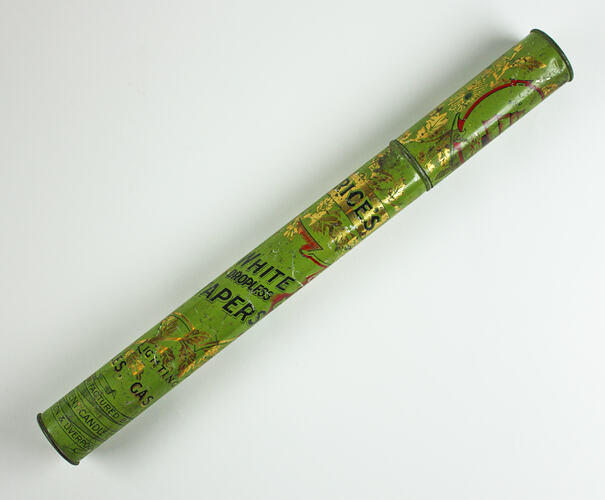Summary
Alternative Name(s): Candles
Cylindrical tin containing unused wax tapers, Ship Brand, made by Price's Candles circa 1880-1910. Tapers were essentially wax-coated wicks used to light gas or kerosene appliances or candles. Price's developed its 'Ship Brand' trademark in the 1870s, featuring the image of a clipper ship under sail. It was used for both home and export products.
Price's Candles was founded in 1830 by William Wilson, who established a candle factory on Wandsworth Road, Vauxhall, South London, and a crushing mill upstream at Battersea, making candles from coconut fat imported from Ceylon (now Sri Lanka). In the late 1830s, the company pioneered the use of palm oil from palm trees in West Africa as an alternative raw material for candle wax, and George Wilson developed the technique of using sulphuric acid to remove the brown colour. Limited dockside facilities at Battersea caused the factory to be moved to Liverpool. In 1840 there were 84 staff, and by 1855, 2,300.
By 1900, Price's was the largest manufacturer of candles in the world. In 1919 the company was bought by Lever Brothers Ltd, and after a number of changes of ownership during the 20th century survives to this day.
Physical Description
Cylindrical pressed metal tin decorated in green and gold with inscription. Removable lid. Contains 24 tapers, of three types (suggesting different sources, stored in the one container): 18 clean white tapers, each approximately 305mm long; five dirty white tapers, each approximately 255mm long; and a single thin, folded taper broken at several places, approximately 580mm long.
Significance
The distinctive tin of Price's Patent Dropless Tapers is significant as an evocative reminder of typical packaging and branding of household products in the late 19th century and the large export trade that developed between British manufacturers and Australia before World War I. Price's adoption of the 'Ship Brand' with the logo of a clipper ship under full sail reflects a type of sailing ship technology that played a significant role in the movement of immigrants from Britain to Victoria during the gold rushes of the 1850s and continued until the turn of the century carrying much of the trade in British manufactured goods exported to Victoria. The demand for wax tapers is today confined primarily to the lighting of church candles, but in the pre-electric age before the First World War, the packet or tin of tapers had an essential place on the mantelpiece of almost every household in a city lit by candles, gas lights and kerosene lamps.
More Information
-
Collecting Areas
Home & Community, Engineering, Public Life & Institutions, Transport, Migration & Cultural Diversity
-
Acquisition Information
Donation from Ms Dimity Reed, 07 Apr 2008
-
Date Made
-
Inscriptions
'SHIP / BRAND' (in circular surrounding image of a clipper ship under sail), 'PRICE'S / WHITE / DROPLESS / TAPERS / FOR LIGHTING / CANDLES, GAS &c' / 'MANUFACTURED BY / PRICE'S PATENT CANDLE COY LTD / LONDON & LIVERPOOL'
-
Classification
-
Category
-
Discipline
-
Type of item
-
Overall Dimensions
311 mm (Height), 32 mm (Outside Diameter)
Dimensions of tin
-
References
Annear, Robyn (2005). A City Lost & Found - Whelan The Wrecker's Melbourne, Black Inc, Schwartz Publishing Pty Ltd, Melbourne, pp.62-69. Price's Patent Candles Ltd website, [Link 1] & [Link 1]history/historydetail.asp, printed 12/9/2008. Price's Candles Wikipedia, [Link 3] printed 12/9/2008. Industrial History of Vauxhall website, [Link 4] printed 12/9/2008.
-
Keywords



